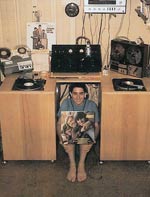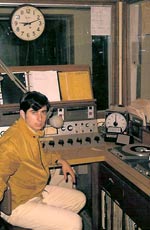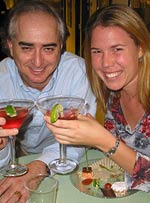The Norm Garr Collection
|
|
The announcing bug hit Norm Garr very early in life, when among a collection of birthday gifts there was a "working" microphone and speaker. Hours of listening to KFWB and KHJ in the 60's kept the "announcing" bug alive, including many opportunities to sit in on the Johnny Williams show at the Boss Radio station.His first real DJ job was in the summer of 1970 as a weekender at KUDU, Ventura, CA., a "BOSS" country station that had every Drake-type jingle, a SOLID GOLD weekend, et. al.
For his senior project at San Diego State University, Norm interviewed a number of air personalities, including Robert W. Morgan and B. Mitchell Reed. (Some day, down the road, those interviews might show up in the Repository). Also, during his time at SDSU from 1970-1972, Norm netted some "golden" time with legendary programmer Ron Jacobs at KGB, where Norm was interning — and that was after a previous internship at KCBQ with Buzz Bennett & Rich Brother Robbin. Bobby Ocean, Shotgun Tom Kelly, Eric Chase, Barry Kaye, Christopher Cane, K.O. Bailey and Chuck Browning were among the personalities working in San Diego at the time. WOW! After returning to LA to spend three years working as a news assistant at KNXT-TV and a sports producer at KFI radio, Norm did weekends and fill-in again at KUDU, and then KACY in Ventura, CA., until he went to Longview, WA. for two years as a news director and operations manager. Norm returned to LA to pursue his dream of working in network television, which he did for three years at NBC. His "executive assistant" roles have taken him to the every major motion picture studio in Hollywood, including eight years at Disney and almost four years at MGM/UA. Norm is presently (and possibly, permanently) retired, but very busy doing all the things he never had the time to do while working 50-60 hours weeks in the "biz." |
The Repository thanks Norm Garr for sharing!
There are so many hits from 1966 (as you’ll hear in the full length songs as well as the clips from others), that this program should have run four hours! 1966 “marks” the first of several appearances by super talent Mark Elliott as host, with Bill Drake as image voice.
Ronald Reagan “takes over” California; A lot of high-flying birds are grounded; more transportation woes rock the Big Apple; The Real Don Steele “IS” number one; and what do The Monkees and Mrs. Miller have in common?
Mama Cass Elliott (no relation to Mark) tells us they weren’t quite sure what musical theatre they were a part of; Paul Revere & The Raiders broke the mold at one major record label; Terry Kirkman from The Association struggled to find the words to one of their biggest hits; Herb Alpert gives us a “taste” of how it all works; and Stevie Wonder digs deep and pulls from “experience” to generate hit after hit.
The KHJ version of THE GOLDEN YEAR: 1966
There are so many hits from 1966 (as you’ll hear in the full length songs as well as the clips from others), that this program should have run four hours! 1966 “marks” the first of several appearances by super talent Mark Elliott as host, with Bill Drake as image voice.
Ronald Reagan “takes over” California; A lot of high-flying birds are grounded; more transportation woes rock the Big Apple; The Real Don Steele “IS” number one; and what do The Monkees and Mrs. Miller have in common?
Mama Cass Elliott (no relation to Mark) tells us they weren’t quite sure what musical theatre they were a part of; Paul Revere & The Raiders broke the mold at one major record label; Terry Kirkman from The Association struggled to find the words to one of their biggest hits; Herb Alpert gives us a “taste” of how it all works; and Stevie Wonder digs deep and pulls from “experience” to generate hit after hit.
The KHJ version of THE GOLDEN YEAR: 1966
The Summer Of Love is in full swing on the West Coast; one of the world’s greatest athletes says NO to Uncle Sam; and “B&C” are shooting first and asking questions later!
Bill Drake and Robert W. Morgan return in their customary roles as image voice and narrator.
Aretha Franklin says she has Otis Redding to thank for her signature hit; Felix Cavaliere of The Rascals tells us why Sunday was his “fun day” long before The Bangels said so; Frank Valli confesses he can’t tell a lie in regards to his first solo hit; Lulu has friends who can produce hits faster than it takes to boil water; and Glen Campbell and John Hartford recall gentle beginnings.
The Drake-Chenault version of THE GOLDEN YEAR: 1967
The Summer Of Love is in full swing on the West Coast; one of the world’s greatest athletes says NO to Uncle Sam; and “B&C” are shooting first and asking questions later!
Bill Drake and Robert W. Morgan return in their customary roles as image voice and narrator.
Aretha Franklin says she has Otis Redding to thank for her signature hit; Felix Cavaliere of The Rascals tells us why Sunday was his “fun day” long before The Bangels said so; Frank Valli confesses he can’t tell a lie in regards to his first solo hit; Lulu has friends who can produce hits faster than it takes to boil water; and Glen Campbell and John Hartford recall gentle beginnings.
The Drake-Chenault version of THE GOLDEN YEAR: 1967
It’s a year of highs and lows for the USA with two political assassinations. The country enjoys Olympic success and tries to deal with it all by taking some good advice: just let your hair down for a while.
Bill Drake and Robert W. Morgan are the voices behind 1968 in this KHJ-specific version of the program with ample jingles and month-specific news highlights. And, we finally get the official copyright announcement that seems to have vanished from previously-presented GOLDEN YEAR chapters.
16 GOLDENS include: some psychedelic “cream”; you’ll learn why I’ve been so hyper since birth; what those Rascals believe everyone must be; we visit with that lady who’s trying to seduce Dustin Hoffman; and we will discover the true color of LOVE!
Gary Puckett of The Union Gap shares his secrets for the success of the group’s hit records; John Kay of Steppenwolf says timing is everything; Bobby Goldsboro is surrounded by the best in the business; Bert Bacharach has a few “million sellers” just lying around, so he gives one to Herb Alpert; and P.T.A. politics inspire Jeannie C. Riley’s biggest hit!
KHJ’s version of THE GOLDEN YEAR: 1968
It’s a year of highs and lows for the USA with two political assassinations. The country enjoys Olympic success and tries to deal with it all by taking some good advice: just let your hair down for a while.
Bill Drake and Robert W. Morgan are the voices behind 1968 in this KHJ-specific version of the program with ample jingles and month-specific news highlights. And, we finally get the official copyright announcement that seems to have vanished from previously-presented GOLDEN YEAR chapters.
16 GOLDENS include: some psychedelic “cream”; you’ll learn why I’ve been so hyper since birth; what those Rascals believe everyone must be; we visit with that lady who’s trying to seduce Dustin Hoffman; and we will discover the true color of LOVE!
Gary Puckett of The Union Gap shares his secrets for the success of the group’s hit records; John Kay of Steppenwolf says timing is everything; Bobby Goldsboro is surrounded by the best in the business; Bert Bacharach has a few “million sellers” just lying around, so he gives one to Herb Alpert; and P.T.A. politics inspire Jeannie C. Riley’s biggest hit!
KHJ’s version of THE GOLDEN YEAR: 1968
Bill Drake and Charlie Van Dyke are your image voices; Mike Cleaver is our news guy and Robert W. Morgan takes us through the final year of the decade many believe was the most influential in rock (let alone – all) music: 1969!
Everyone’s gone to the moon; the other New York wins the World Series, and as Humble Harve might say: it is time to SPREAD peace and LOVE, baby! Call out the Mounties; IKE Dies; Charles “DeG.” calls it quits; did you wear a Maxicoat, and Joe Namath is on top of his game!
Tommy James tells us all he needed was a rhyming dictionary; John Fogerty says he was the “man in the middle”; The Guess Who only have “eyes” for hits; Florence Gordon from The 5th Dimension shares how two is better than one; and just how BIG were The Archies?
One additional note: A whole lot of people were scratching their heads when we first heard the news voice on this syndicated version of the GOLDEN YEAR 1969. We all thought it HAD to be someone connected with KHJ, but, as it turned out, that was not the case. I played a clip of Cleaver’s voice for a number of people and only after Humble Harve suggested it had to be someone from Canada did REELRADIO contributor Jon Pearkins identify the voice as Mike Cleaver. Cleaver told me CHUM in Toronto produced a number of documentaries with news included and sold them to other production companies, which is probably how Drake/Chenault obtained them.
Drake/Chenault’s syndicated version of THE GOLDEN YEAR: 1969
Bill Drake and Charlie Van Dyke are your image voices; Mike Cleaver is our news guy and Robert W. Morgan takes us through the final year of the decade many believe was the most influential in rock (let alone – all) music: 1969!
Everyone’s gone to the moon; the other New York wins the World Series, and as Humble Harve might say: it is time to SPREAD peace and LOVE, baby! Call out the Mounties; IKE Dies; Charles “DeG.” calls it quits; did you wear a Maxicoat, and Joe Namath is on top of his game!
Tommy James tells us all he needed was a rhyming dictionary; John Fogerty says he was the “man in the middle”; The Guess Who only have “eyes” for hits; Florence Gordon from The 5th Dimension shares how two is better than one; and just how BIG were The Archies?
One additional note: A whole lot of people were scratching their heads when we first heard the news voice on this syndicated version of the GOLDEN YEAR 1969. We all thought it HAD to be someone connected with KHJ, but, as it turned out, that was not the case. I played a clip of Cleaver’s voice for a number of people and only after Humble Harve suggested it had to be someone from Canada did REELRADIO contributor Jon Pearkins identify the voice as Mike Cleaver. Cleaver told me CHUM in Toronto produced a number of documentaries with news included and sold them to other production companies, which is probably how Drake/Chenault obtained them.
Drake/Chenault’s syndicated version of THE GOLDEN YEAR: 1969
Robert W. Morgan returns to usher in the dawn of a new decade with 13 featured songs from the GOLDEN YEAR 1970.
In the headlines: Paul McCartney wants to sever his Beatle “bonds”; air traffic controllers take a “sick” day; we celebrate Earth Day; and you don’t have to be 21 to vote!
B.J. Thomas tells why he had to “re-cut” one of his biggest hits; Karen Carpenter found her #1 in Herb Alpert’s desk; Burton Cummings explains why the women “look so different” in Canada, and Freda Payne says the first time is the right time! (Warning: Ms. Payne’s comments contain mature subject matter!)
Drake/Chenault’s syndicated version of THE GOLDEN YEAR: 1970
Robert W. Morgan returns to usher in the dawn of a new decade with 13 featured songs from the GOLDEN YEAR 1970.
In the headlines: Paul McCartney wants to sever his Beatle “bonds”; air traffic controllers take a “sick” day; we celebrate Earth Day; and you don’t have to be 21 to vote!
B.J. Thomas tells why he had to “re-cut” one of his biggest hits; Karen Carpenter found her #1 in Herb Alpert’s desk; Burton Cummings explains why the women “look so different” in Canada, and Freda Payne says the first time is the right time! (Warning: Ms. Payne’s comments contain mature subject matter!)
Drake/Chenault’s syndicated version of THE GOLDEN YEAR: 1970




